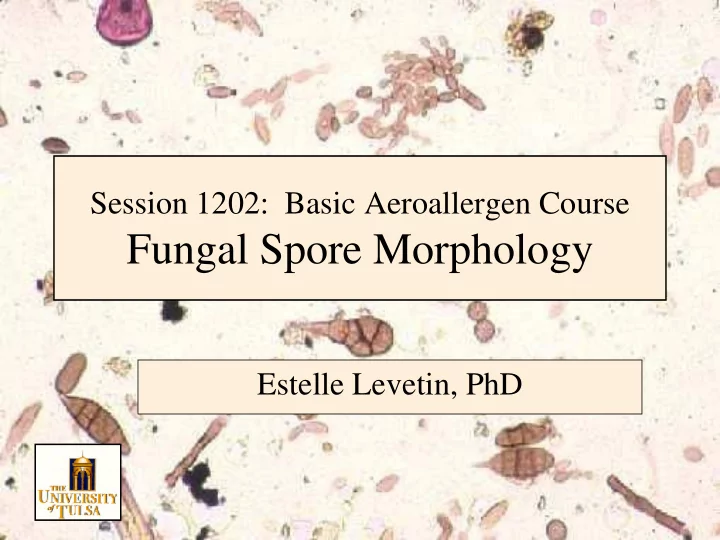

Session 1202: Basic Aeroallergen Course Fungal Spore Morphology Estelle Levetin, PhD
Disclosure • No conflicts to disclose
Fungal Spore Characteristics
Characteristics • Spore size • Spore shape • Number of cells • Attachment Scars • Wall characteristics • Spore color
Spore Size, Shape, and Septation • SIZE : 2 m m to 100 mm • SHAPE : Globose, elliptical, fusiform, asymmetric, lemon-shaped, barrel-shaped, curved • SEPTATION : Non-septate (one cell), single septum, transverse septa, transverse and longitudinal septa, random septa, pseudoseptate
Other Characteristics • ATTACHMENTS : Attachment scars, attachment pegs • APPENDAGES • WALL CHARACTERISTICS: Smooth, granular, reticulate, spines, warts, wall thickness • COLOR : Hyaline (colorless) to deeply pigmented
Globose Barrel-shaped Non-septate Random septa Lemon-shaped Club-shaped Transverse septa Attachment scars Elliptical Curved Transverse and Ornaments: spines Longitudinal septa Cylindrical Pseudoseptate Appendages Asymmetric and germ pore
Spore color
Asexual Spores Also known as Deuteromycetes, Fungi Imperfecti (imperfect fungi), or Mitospores
Asexual Spores • Typically the most abundant spores in the atmosphere • Conidia often formed on specialized hyphae called conidiophores • Asexual stage of ascomycetes • Look for attachment scars where the spores were attached to the conidiophore or to each other
Cladosporium
Cladosporium Note the septum
Several species of Cladosporium are common in the atmosphere
Note the prominent attachment scars on Cladosporium conidia
Alternaria
Alternaria
Curvularia
Nigrospora Curvularia Drechslera
Drechslera-type spores • Several genera of fungi have similar cylindrical spores – Drechslera – Bipolaris – Exserohilum – Helminthosporium
Drechslera- type spores
Pithomyces
Note the colorless attachment at the base of Pithomyces spores
Pithomyces in culture
Epicoccum
Epicoccum spore cluster (sporodochium)
Penicillium species • Produce distinctive conidiophores (spore bearing structures) • Spores are usually spherical to oval and form in chains
Aspergillus species • Produce distinctive conidiophores (spore bearing structures) • Spores are usually spherical to oval and form in chains
Penicillium-Aspergillus type spores
Penicillium-Aspergillus type spores
Aspergillus niger spores Aspergillus niger in culture
Fusarium
Botrytis
Oidium
Other Asexual Spores on the NAB Count sheet
Cercospora
Nigrospora Nigrospora Culture Air Sample
Periconia
Polythrincium Peronospora
Stemphylium
Torula
Other Asexual Spores NOT on the NAB Count Sheet
Spegazzinia
Tetraploa
Pestalotiopsis
Stachybotrys
Division Ascomycota
Eight ascospores are produced in each ascus without any attachment scars
Ascospores are sometimes found in groups of eight in air samples
*Leptosphaeria ascospores
*Chaetomium ascospores
*Pleospora ascospores
Diatrypella ascospores (*Family Diatrypaceae)
Phaeosphaeria annulata Bright field Phase contrast
Sporomiella ascospores
Venturia ascospores
Paraphaeosphaeria ascospore
Leptosphaerulina ascospore
Various ascospores
Many ascospores on a rainy day
Division Basidiomycota
Attachment Basidiospore Basidium
*Ganoderma basidiospores
Other basidiospores that are easy to recognize * Coprinus-type *Agrocybe- type
Coprinus and Ganoderma basidiospores
Psathyrella velutina Psathyrella Russula Stropharia
Boletus Thelephora Chlorophylum Galerina
Lycoperdon Calvatia Pisolithus Scleroderma
Mixed Basidiospores
Rust spores: Puccinia Puccinia uredospores Puccinia teliospores
Smut Spores
Smut Spores
Myxomycete (slime mold) spores
Other slime mold spores
Recommend
More recommend